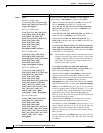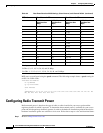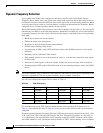
6-17
Cisco IOS Software Configuration Guide for Cisco Aironet Access Points
OL-29225-01
Chapter 6 Configuring Radio Settings
Configuring Radio Channel Settings
Because they change frequently, channel settings are not included in this document. For up-to-date
information on channel settings for your access point or bridge, see the Channels and Maximum Power
Settings for Cisco Aironet Autonomous Access Points and Bridges. This document is available on
cisco.com at the following URL:
http://cisco.com/en/US/products/ps6521/tsd_products_support_install_and_upgrade.html
Channel Widths for 802..11n
802.11n allows both 20-MHz and 40-Mhz channel widths consisting of 2 contiguous non-overlapping
channels (for example, 2.4-GHz channels 1 and 6). 802.11n radios operate in the same band. However
the channel widths can be independently configured.
One of the 20-MHz channels is called the control channel. Legacy clients and 20-MHz high throughput
clients use the control channel. Beacons can only be sent on this channel. The second 20-MHz channel
is called the extension channel. 40-MHz stations may use this channel and the control channel
simultaneously.
A 40-MHz channel is specified as a channel and extension, such as 1,1. In this example, the control
channel is channel 1 and the extension channel is above it.
Beginning in privileged EXEC mode, follow these steps to set the wireless device channel width:
Command Purpose
Step 1
configure terminal Enter global configuration mode.
Step 2
interface dot11radio {0 | 1} Enter interface configuration mode for the radio interface.
The 2.4-GHz radio and the 802.11n 2.4-GHz is radio 0.
The 5-GHz radio and the 802.11n 5-GHz is radio 1.
Step 3
channel
{frequency | least-congested |
width [20 | 40-above | 40-below]
| dfs}
Set the default channel for the wireless device radio. To search for
the least-congested channel on startup, enter least-congested.
Use the width option to specify a bandwidth to use. This option is
available for 1140 and 1250 series access point and consists of
three available settings: 20, 40-above, and 40-below. choosing 20
sets the channel width to 20 MHz. Choosing 40-above sets the
channel width to 40 Mhz with the extension channel above the
control channel. Choosing 40-below sets the channel width to 40
MHz with the extension channel below the control channel.
Note The channel command is disabled for 5-GHz radios that
comply with European Union regulations on dynamic
frequency selection (DFS). See the “Setting the 802.11n
Guard Interval” section on page 6-22 for more information.
Step 4
end Return to privileged EXEC mode.
Step 5
copy running-config
startup-config
(Optional) Save your entries in the configuration file.


















